Creation Station: Making Space for Crafts and Hobbies
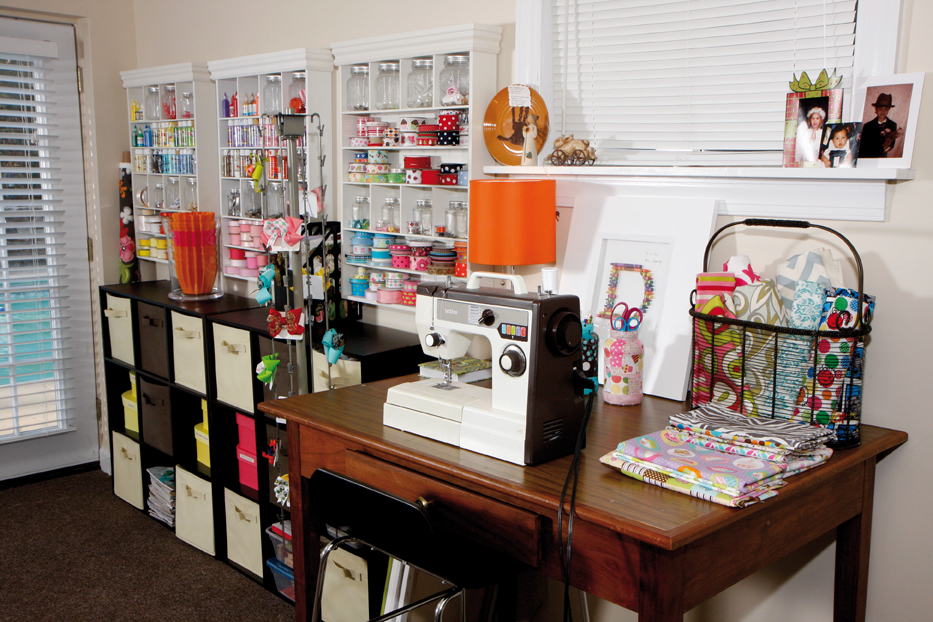 Everyone has one — that “catch-all” drawer, typically in the kitchen or office, that holds everything from scissors, tape and glue, to pipe cleaners, bottlecaps, a needle and thread and other scraps for half-finished craft projects. Sometimes that drawer spills over into another drawer, or to a whole cupboard, corner or even a whole room.
Everyone has one — that “catch-all” drawer, typically in the kitchen or office, that holds everything from scissors, tape and glue, to pipe cleaners, bottlecaps, a needle and thread and other scraps for half-finished craft projects. Sometimes that drawer spills over into another drawer, or to a whole cupboard, corner or even a whole room.
As the holiday season comes and goes, HOME offers you some tips to finally complete those projects by creating a clutter-free area in your home where your creativity can truly shine.
Repurposing a Space
In the weeks leading up to Christmas and for other celebrations throughout the year, many people tackle homemade gifts—that photo album for Mom, the knitted scarf for Aunt Sue, those cute sock pets for the kids. But if you’re like many busy people with a household to run, you may have only gotten as far as collecting the materials—and they’re probably piling up in a disorderly fashion. Finding the right space to work is the challenge. And a recent study for the Craft & Hobby Association (CHA) shows the typical crafter/hobbyist spends an average of 7.5 hours per week engaged in a craft or hobby. If you’re going to spend close to a full day’s time at something you love each week, you ought to love the space where you’re doing it.
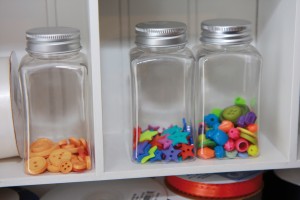 Local Laura Dawson loves her crafting space, a designated area in her family home’s basement. An avid crafter, she enjoys sewing, painting and crafting all kinds of items, especially for children—like wall art, bibs, burpcloths, backpacks and more. Carefully organized and beautifully displayed, her craft supplies fill several wall-mounted shelves, while less visually pleasing supplies and tools are housed in fabric bins on shelves below. High windows and French doors to the outside let in plenty of natural light during the day.
Local Laura Dawson loves her crafting space, a designated area in her family home’s basement. An avid crafter, she enjoys sewing, painting and crafting all kinds of items, especially for children—like wall art, bibs, burpcloths, backpacks and more. Carefully organized and beautifully displayed, her craft supplies fill several wall-mounted shelves, while less visually pleasing supplies and tools are housed in fabric bins on shelves below. High windows and French doors to the outside let in plenty of natural light during the day.
“My space started out as a closet,” Laura said. “My husband knew I had a passion for it, and once I really started getting in to it, he said, ‘You really do need a space of your own.’” She didn’t need four walls and a door, instead maximizing available wall space for storage and working at a generous drafting table made by her husband’s grandfather, where she can stand comfortably to paint, or pull up a stool to sew. Her children (ages 5, 7 and 9) know that while they are occasionally invited to collect items from her extensive collection of crafting goodies to make their own creations, this space is “just for Mommy,” she explained.
Being able to see her array of organized supplies is her favorite aspect of this area, because it allows her to see everything she has, which keeps the creative juices flowing. She also displays photos of her children and special pieces of handcrafted artwork in her space for inspiration.
Kathy Harris of Amherst said she spends several hours each day in her large craft room. The room is the result of a last-minute decision she made when building her new home several years ago. “It’s the area over the three-car garage that was really going to be nothing,” she explained. “I said, ‘Ah, ha! That will be my studio.’”
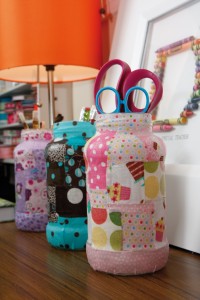 As a painter, seamstress and craftsperson, she makes use of every inch of the spacious room, which also doubles as a guestroom. A large table left over from her husband’s time in the printing business allows her to work on bigger projects and has many drawers and cubbies to hold supplies. She also has file cabinets, a sewing machine and stand, two beds, a love seat, a television, a cabinet where she can display her finished work, a draftsman’s table for her artwork, and a shelf for her own library of art books. There is also an adjoining full bathroom, which makes for easy cleanup.
As a painter, seamstress and craftsperson, she makes use of every inch of the spacious room, which also doubles as a guestroom. A large table left over from her husband’s time in the printing business allows her to work on bigger projects and has many drawers and cubbies to hold supplies. She also has file cabinets, a sewing machine and stand, two beds, a love seat, a television, a cabinet where she can display her finished work, a draftsman’s table for her artwork, and a shelf for her own library of art books. There is also an adjoining full bathroom, which makes for easy cleanup.
Harris’ specialty is angel figurines, which she makes as a ministry. She has given away close to 400 through her church’s bereavement committee, to nursing homes and to those who are sick. The ongoing project means she has to stay organized. She never knows when she will get an order. “All my gold trim for the angels is in one cabinet here; right next to it is the desk where I make the angels; next to that is a basket where all the kits that I make up for the angels are,” she said.
She has it down to a process for sure, but it comes easy to the self-proclaimed “born-organized person.” To an avid crafter like Harris, organization is indeed the key.
Getting Organized
Even if you don’t have a special room, a large area, or even a closet with leftover real estate, you can still fashion your own creation station. Consider procuring and organizing for yourself a self-contained portable unit that contains all the things you need to work on a particular project. A large plastic tub with a lid could do the trick; a lidded basket is another great choice, particularly because the basket could stay out of hiding as part of your home décor—making you more likely to work on your craft without having to haul anything out from the back of a closet.
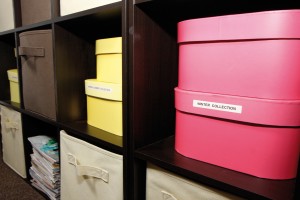 The key is organization, which has become an art all in itself. Picking the right type of containers for your different craft supplies — in the right sizes — is quite a skill. The first thing to do is take stock of what you have, and make note of what you need. If you enjoy multiple crafts in different disciplines, try to keep the accoutrements separate in designated containers or areas. Also, group items typically used in every craft project, such as scissors, glue guns and tape, and keep these items easily accessible, such as in a drawer, small plastic bin, or on a shelf above your workspace.
The key is organization, which has become an art all in itself. Picking the right type of containers for your different craft supplies — in the right sizes — is quite a skill. The first thing to do is take stock of what you have, and make note of what you need. If you enjoy multiple crafts in different disciplines, try to keep the accoutrements separate in designated containers or areas. Also, group items typically used in every craft project, such as scissors, glue guns and tape, and keep these items easily accessible, such as in a drawer, small plastic bin, or on a shelf above your workspace.
Gone are the days when you had to save shoeboxes and pill bottles for all your do-dads; today’s sturdy containers are built to last. Many retailers offer decorative storage boxes, crates, baskets, trunks, stacking bins and more. They come in all sizes and colors, with the popular translucent option so you can quickly locate supplies.
And container manufacturers are getting smarter. They know that finding a central spot in your home to both store supplies and work on your crafts is often hard, so they’ve created off-the-shelf workstations. These freestanding units often consist of drawers of various sizes, a countertop for working and a basket attached to the side for holding taller items, such as gift wrap. If your crafting is limited to gift wrap, consider a workstation made just for that purpose—a fold-up table of sorts, doubling as storage for supplies and a surface for wrapping gifts. When the lid is shut, a clip on top secures a roll of wrap, and grid lines guide your cutting. And when the holiday season is over, the workstation folds down to store under a bed or on a shelf. It can be done!
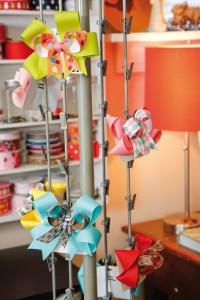 Creating a Family Center
Creating a Family Center
Although a craft nook may sound like a hobbyist’s dream, the reality is that many of us are already maxed out when it comes to space in our homes.
Matalie Howard, a Family and Consumer Sciences professor at Liberty University, said a craft room may not be all that practical in a busy household, but there are ways to make a multipurpose room—a “family center,” if you will—where everyone in the household can enjoy their own personal activities, including crafts and hobbies.
“Crafters have been told for years that we should have a special room in our homes dedicated to our craft. A place—behind closed doors—where we can create, where we can relax, without interruption and without bothering others. I choose to differ,” she said. “Not everyone wants to be closed away from the rest of the family.” For that reason, she suggests doing the best you can with what you have, making your workspace blend in with a room everyone can use. “I sincerely believe that many individual activities can be enjoyed in the same room,” she said.
To create a comfortable family center — a dining room, kitchen, family or living room — first make sure the room meets the needs of each person, Howard said. Choose furnishings that are easily cleaned, not easily damaged nor likely to cause injury. Use cabinetry with doors to secure supplies such as scissors, tape, and paper for scrapbooking or pins, scissors, and patterns for sewing. The general lighting can be varied in intensity, she said, with dimmer switch controls and task lighting provided for specific activities.
With these tips, she said, your work area can also become a place where you enjoy one another’s company. “Individual family members are typically very busy throughout the day with schedules for work, school, play, extracurricular activities, etc. Family centers are places you go home to.”
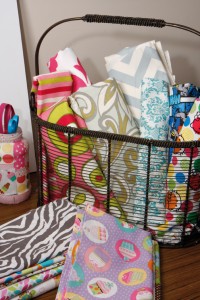 So whether you want a place for everyone to dream and design together, or a refuge to relax into your own creative endeavors, making your own creation station is easier than ever with these ideas and inspiration. Get organized, get those creative juices flowing, and get crafting just in time for the holidays and those long winter afternoons that follow.
So whether you want a place for everyone to dream and design together, or a refuge to relax into your own creative endeavors, making your own creation station is easier than ever with these ideas and inspiration. Get organized, get those creative juices flowing, and get crafting just in time for the holidays and those long winter afternoons that follow.
Inspired to make your own creation station without breaking the bank? Consider the following tips from the Craft & Hobby Association:
Make your own craft table by purchasing a plain, smooth 6-foot secondhand or damaged interior door (found inexpensively at most lumber companies) or a piece of half-inch plywood cut to the desired size. Cover it with fabric or plastic. Take two two-drawer metal file cabinets and place one cabinet under each end of the door or plywood. Use the cabinets for your crafting supplies and projects.
Use coffee mugs to hold paint brushes, craft knives, pliers and other supplies.
For storage and organization, use clear plastic shoeboxes, baby food jars and resealable plastic bags. A fishing tackle box has lots of little compartments, making it especially useful for smaller crafting supplies like beads and sparkles. Plus, it’s portable.






